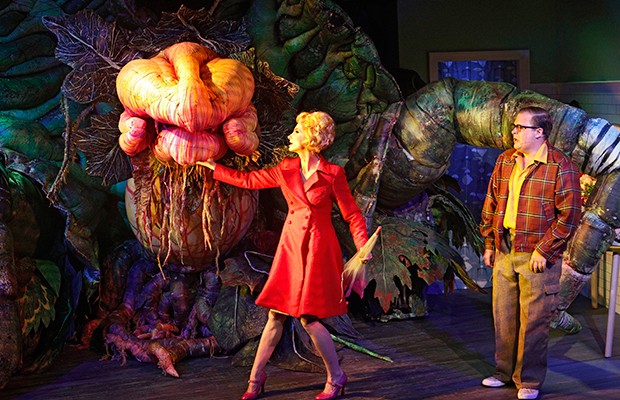LITTLE SHOP OF HORRORS REVIEW (HAYES THEATRE, SYDNEY)
- February 24, 2016

When director Dean Bryant, musical director Andrew Worboys and choreographer Andrew Hallsworth opened the Hayes Theatre with their landmark production of Sweet Charity in early 2014, they signalled an almighty change in how musical theatre can be approached as an art form in Sydney.
So they were always going to have high expectations to live up to for their follow-up Hayes production of the 1982 cult hit Little Shop of Horrors. It’s a great thrill to be able to say they’ve done it again.
With a tight book and lyrics by Howard Ashman and a sweet ’60s pop-inspired score by Alan Menken, Little Shop of Horrors is calling out less for the kind of major reinvention Bryant and co gave to Sweet Charity. And while the team has ramped up the volume of just about every production element, and found a few surprises, they’re faithful to the core of the material.
Thanks to the hit 1986 film version, as well as the countless community productions of the show that happen every year, most audience members are familiar with the plot. Seymour (Brent Hill) is an orphaned florist’s assistant, desperately in love with his co-worker, the beautiful but troubled Audrey (Esther Hannaford). When he discovers a “strange and interesting” plant, which he names the “Audrey II”, his fortunes change immediately. But Audrey II soon develops a taste for human blood, and corrupts the sweet-natured Seymour, who will do anything to rise up and win the girl.
Little Shop of Horrors is one of the most successful Off Broadway musicals of all time for a couple of reasons: its spoofing of B-grade horror flicks is spot-on, with a villain like no other, it continuously draws laughs with its inherent absurdity, and there’s a beautiful, quietly sweeping romance driving the story forth.
But at the heart of the musical is a story about two lonely young people cast aside by society, desperately trying to find a way out of their dire, poverty-stricken circumstances. In that sense, it’s an interesting companion piece to Sweet Charity: although they’re miles apart in terms of style and narrative, both are underpinned by an exploration of how the American dream fails the downtrodden. To inject those more cynical and critical themes into the American musical theatre is surprisingly potent and challenging, and makes the work relevant for Australian audiences in 2016.
Bryant’s major reinvention in this production comes with the role that Audrey II plays. The various puppets which represent Audrey II have been designed by Erth Visual & Physical Inc, and they’re all first-class. The largest one takes over the entire Hayes space, with a long, snake-like torso and two huge leaves flared out, almost like a frill-necked lizard. It’s a brilliant technical achievement.
But what really makes this Audrey II special is that instead of being voiced by an offstage singer, Brent Hill, who plays Seymour, provides the plant’s voice live on stage (which you can read more about here). It’s a spectacular achievement for the actor, who is rapidly switching between two vastly different vocal characters in the number Feed Me (Git It), while maintaining Seymour’s physicality. It needs to be seen to be believed.
It’s also a surprisingly subtle choice — because Hill is constantly so physically committed to the one character, it’s easy to not even notice he’s providing Audrey II’s voice — and open to all kinds of interpretations. To my mind, Audrey II is using Seymour and speaking through him, but the openness of the choice is part of its appeal.
And Esther Hannaford’s performance as Audrey is just as astonishing. She takes flavours of what Ellen Greene did in the original production and the film (it’s a performance so iconic and so embedded in that character it’s almost impossible to ignore) and adds a slightly more Monroe-esque quality, nailing the comedy.
She also finds the full darkness of the character, both in her relationship with Seymour and her sadistic dentist boyfriend Orin (Scott Johnson). There’s no shying away from the frailty of Audrey as written — Hannaford’s Audrey absolutely associates abuse with affection — and its very affecting to watch.
The trio of street urchins who also act as a Greek Chorus for the story — played by Josie Lane, Angelique Cassimatis and Chloe Zuel — are full of fire and rough street energy, and set fire to the close three-part harmonies. They’re given some great choreography by Andrew Hallsworth, which takes the movement of the girl groups of the ’60s (who inspired all of the music given to the trio) and ramps it up to something more streetwise and prickly. And having Lane speak in a Filipino accent and Cassimatis in a Puerto Rican accent is a nice touch.
And there are exciting supporting performances from Tyler Coppin as Mr Mushnik, Dash Kruck in a number of guises, and Scott Johnson, who is bone-chilling and genuinely psychopathic as the dentist Orin Scrivello.
There’s one particularly clever idea in the design, which signifies the passage of time, and the invigorating, newfound fortune that Audrey II brings to Seymour and Audrey. I won’t spoil it, but it is brilliantly executed by costume designer Tim Chappel and set designer Owen Phillips.
The band, under Worboys’ musical direction, is perfectly tight and appropriately rowdy, and the levels in Jed Silver’s sound design are generally well-balanced (although the volume of the dialogue could come down just a little).
The only real problem with this production is two moments of slightly awkward pacing. Firstly, Audrey’s act one solo Somewhere That’s Green is a little rushed and the staging is slightly overworked. It’s a problem because this song sets up the entire trajectory for the character and could afford to be a lot more intimate as Audrey reveals her innermost desires (even if Hannaford and Bryant almost make up for it in other ways). And the scene of dialogue leading up to the act two showstopper Suddenly Seymour is similarly rushed, which makes the connection between Seymour and Audrey feel just a little too sudden. (Although that song is staged as an absolutely epic slice of red-hot romance, so you’ve forgotten about all of that by the second verse.)
But these feel like minor complaints (and something quite easily fixed) in a production that consistently rocks, surprises and thrills. This is the Little Shop of Horrors for today: much like Audrey II, it’s overwhelmingly, dazzlingly and terrifyingly alive.
